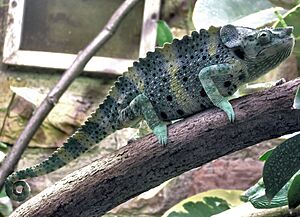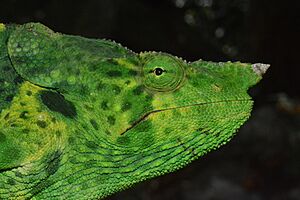Meller's chameleon facts for kids
Quick facts for kids Meller's chameleon |
|
|---|---|
 |
|
| Conservation status | |
| Scientific classification | |
| Genus: |
Trioceros
|
| Species: |
melleri
|
The Meller's chameleon (also known as the giant one-horned chameleon) is a very large type of chameleon. Its scientific name is Trioceros melleri. It's the biggest chameleon found on the African mainland, meaning it doesn't come from Madagascar.
Contents
What's in a Name?
The Meller's chameleon got its common name and scientific name from a person called "Dr. Meller." This Dr. Meller was a botanist named Charles James Meller (1836-1869). He worked in the area that is now Malawi. Biologist John Edward Gray named this chameleon after him in 1865.
Where They Live
You can find Meller's chameleons in the bushy savannas and woodlands of East Africa. They are quite common in countries like Malawi, northern Mozambique, and Tanzania.
Appearance and Features
As the largest chameleons from mainland Africa, adult Meller's chameleons are usually about 30 to 60 centimeters (12 to 24 inches) long. They can weigh from 300 to 500 grams (about 0.6 to 1.1 pounds). Some very big ones have been reported to be up to 76 centimeters (30 inches) long and weigh 600 grams (about 1.3 pounds)!
Female Meller's chameleons are generally a bit smaller than males. Their heads are quite small compared to their bodies and are longer than those of other chameleons in their group.
These chameleons have strong bodies and a short, stubby tail that's about one-third the length of their body. They have a low, bumpy ridge that runs from behind their head down part of their tail. A sharp ridge also goes from their eyes to the tip of their nose, where they have a single small horn.
Meller's chameleons have different kinds of scales on their bodies. They have large, bumpy scales spread evenly on their main body and legs. A special feature is the rows of large, bumpy scales under their chin.
Amazing Color Changes
The basic color of a Meller's chameleon is a deep forest green with white stripes. But like many chameleons, they can change their color depending on what's happening around them.
Their spots and wide vertical bands can be brown, dark green, yellow, or even black. If they are being fed or handled, they might show black and white dots. When they are sunbathing, the side facing the sun might turn dark green or black, while the rest of their body stays lighter.
Meller's chameleons also use color to show if they are stressed.
- A little stress or excitement might show as dark spots over their normal color.
- If they get more upset, these dark green spots turn into black blotches.
- Severe stress can make them turn charcoal gray, then pure white with yellow stripes.
- A sick chameleon might look blotchy with brown, gray, pink, or white.
- A female chameleon that is going to lay eggs will look black, cream, and gray, and her body will be bulging.
Long Tongues
Meller's chameleons have incredibly long tongues. They can shoot their tongues out to catch prey up to 50 centimeters (20 inches) away!
Diet and Reproduction
What They Eat
Like most chameleons, Meller's chameleons are carnivores, meaning they eat meat. Their diet mainly includes insects like crickets, worms, and caterpillars. They also eat smaller lizards and spiders. Very large Meller's chameleons have even been known to eat small birds!
Reproduction and Life Cycle
Female Meller's chameleons lay one group of eggs each year. They can lay up to 80 eggs at a time!
When they first hatch, newborn Meller's chameleons are about 10 centimeters (4 inches) long. For the first three weeks, they need to eat very tiny insects like fruit flies and small crickets. After that, they can eat larger insects such as house flies, locusts, silkworms, and cockroaches. Meller's chameleons can live for as long as twelve years.
Keeping Them as Pets
Meller's chameleons can be shy or a bit aggressive towards humans. Some have even been reported to be friendly! However, chameleons caught in the wild often don't do well as pets because they might have many parasites and get sick easily.
It is possible to breed Meller's chameleons in captivity, but it's not easy. They need very specific care, so they are usually recommended for people who have a lot of experience with reptiles.
Because they are large lizards, they need a very big cage. Some experts suggest placing their cage above human eye level. This helps the chameleon feel safe and high up, like it would in its natural home.
Their enclosure needs to be warm during the day, around 27-29°C (80-85°F). At night, the temperature should drop to about 16°C (low 60s°F) to copy the natural temperature changes in their habitat. They also need a lot of water and special dietary supplements to stay healthy.



